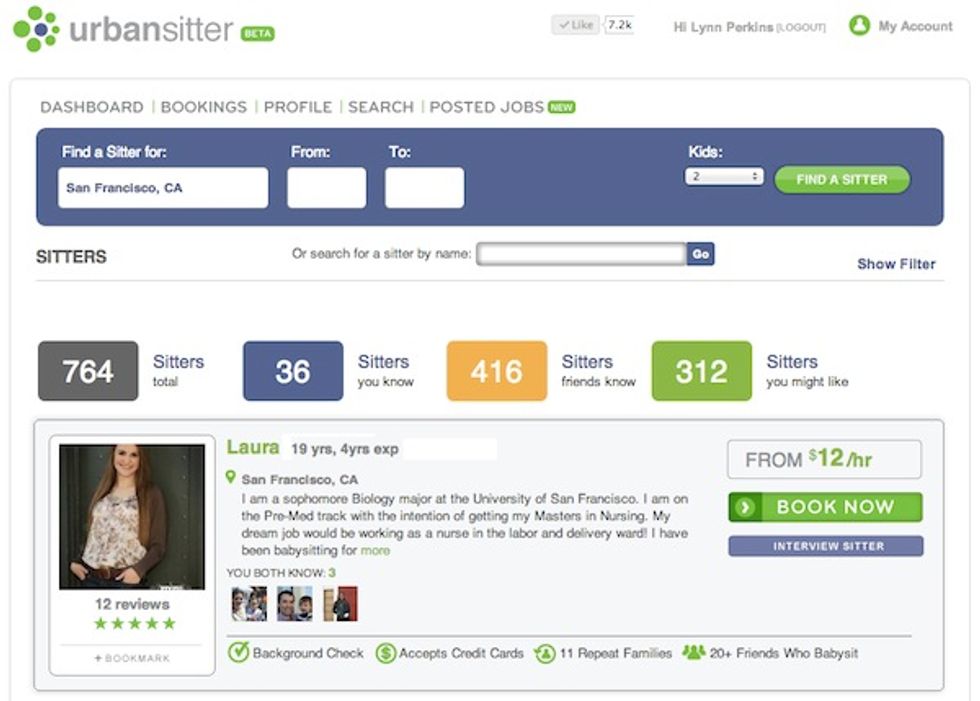Over the past year and a half since its launch, SF-based UrbanSitter has been helping thousands of Bay Area parents connect with babysitters via the social web–to the point where over 9,200 parents and 3,100 sitters are using the service.
UrbanSitter thrives on a combination of trust (leveraging users’ social graph through Facebook Connect), real-time online booking, online payment (which removes the awkwardness of a cash exchange), and the overall efficiency and stickiness of an online marketplace.
As for the all-important trust factor, for Bay Area parents, the average number of people they are connected to on UrbanSitter through shared affiliations (schools, parent groups, kid organizations) is 239. They also, on average, know four Facebook Friends currently using the service.
Over the past year, UrbanSitter has expanded into thirteen cities across the US, including New York, LA and Chicago–and in the process discovered that the Bay Area is apparently the most expensive place to hire a sitter in the country.
According to the data, the average cost for babysitting a single child here is $14/hour, rising to $19.25/hour for three kids. (The comparable rates in New York are $13.50 and $16.50.)
“One reason for this disparity is New York has better public transportation,” says UrbanSitter’s founder Lynn Perkins. "The babysitters say that matters."
Those working as sitters through the service skew heavily female and young – roughly a third are college students, a third recent grads, and another third professional nannies seeking additional work.
Since it released an iPhone app last September, the startup has seen a dramatic reduction in the response time from sitters after parents post a job.
“The sitter response time has been cut from an hour and a half, on average, down to 20 minutes,” she says. “Texting is a more efficient communication method than emails or phone calls. Plus, when the sitters book a job on their phone they update their calendars at the same time. This means they are more reliable and accountable to show up.”
Parents are also finding it is most efficient to stay in touch with sitters via text messages–that is simply the channel of choice for most Millennials.
Other advantages of going mobile are that sitters can peruse job boards when they are away from their computers, and last-minute bookings become much more feasible.
The online platform is proving to be incredibly efficient, even at this relatively early stage of its development, as over 85 percent of all jobs booked get completed and billed. (Over 80 percent of last-minute “panic bookings” get fulfilled as well.)
The company handles the money exchange online with the increasingly common option being a parent paying by credit card and that payment being deposited into the sitter’s checking account.
“The sitters tell us they love that,” Perkins says. “They say they are less likely to spend it than they are when they get cash. And it takes away the awkwardness of the payment moment, which everyone hates. Parents also tend to tip more on a credit card too–something about that blank 'tip' line being there.”
One thing I always like to ask entrepreneurs, once they’ve been operating with real users for a while, is what surprises they’ve discovered in their usage data.
For Perkins, one is an insight into where parents, when they are unable to book their usual sitter, turn next.
“When a parent comes back to the site and their previous sitter is not available, if one of her friends are available they will book her rather than tap into the sitters used by other parents they know.
“So we took that data and told the sitters: ‘If you have to cancel we can show your friends if they are available–do you want to recommend your friends?’”
It turns out they do, in droves.
“They want to help their friends out,” she continues. “And they also know that endorsements and recommendations on the site all improves their ratings. So they like to help their friends do well while doing well themselves. This keeps our active sitters engaged.”
The top sitters in the Bay Area have used UrbanSitter to babysit over 200 times, and the most active parents have used the service more than 100 times. There is a high rate of repeat usage.
The company is currently experimenting with sitters who agree to hold an entire Saturday open for work in two-hour increments in the neighborhoods where they live. This is in response to requests from working parents for some additional support for performing weekend errands, etc.
Also coming later this spring will be an android app to continue serving the growing trend as the entire babysitting marketplace increasingly migrates to mobile platforms.





















